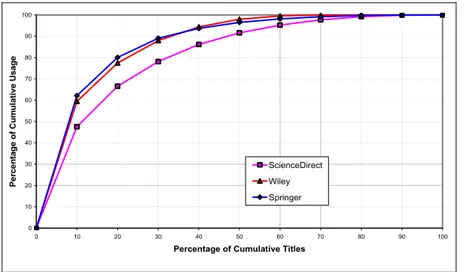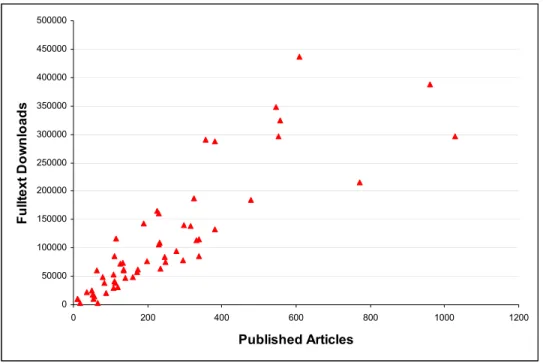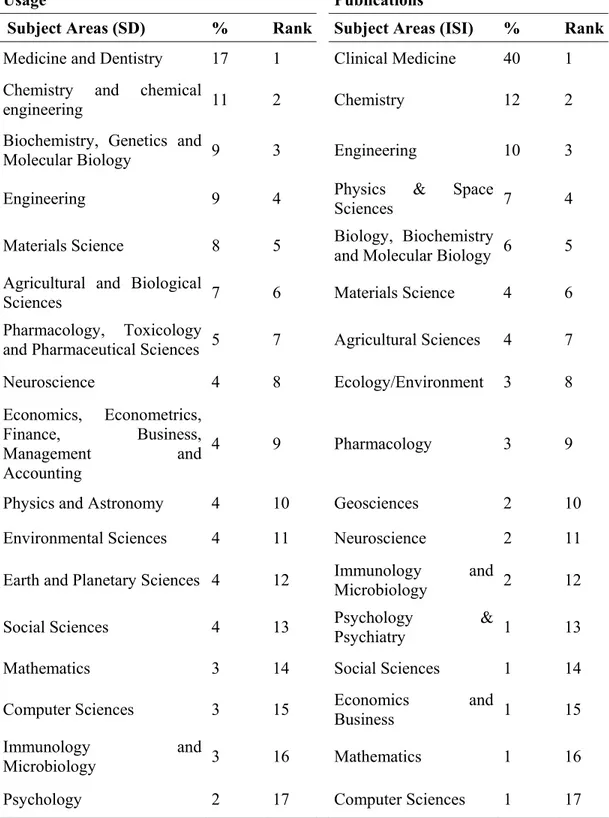Patterns of E-Journal Use within the Anatolian University Library Consortium
Bülent Karasözen, Library Director, Middle East Technical University, Ankara, bulent@metu.edu.tr
Ayhan Kaygusuz, Library Director, Istanbul Technical University, Istanbul, kaygusuz@itu.edu.tr
Hacer (Batı) Özen, Serials Librarian, Middle East Technical University, Ankara, hbati@metu.edu.tr
Abstract: With the establishment of Anatolian University Library Consortium (ANKOS), the number of accessible databases and usage of electronic journals has increased rapidly. Due to the diversity of the universities, differences in usage for various subject collections are observed. In this study, a comparison between the research activity in Turkey and electronic journal usage through the Anatolian University Library Consortium has been carried out. The data of the total and subject- based full-text article usage indicate a strong correlation between the number of published articles and their usage. Additionally, a rank analysis was conducted to establish similarities and differences between each institution’s usage with the aggregated consortium usage.
ANKOS and the higher education system of Turkey:
The Anatolian University Library Consortium (ANKOS) was founded in 2001. The development of the consortium up to 2005 has been documented in two recent articles[1,2]. The majority of ANKOS members are universities; but membership is also open to special (research) libraries. ANKOS is an opt-in consortium; all contracts allow new members to join later on the agreed conditions such as CIBER [3] and NESLI. Over time, joining the consortium has become the only option for many libraries which want to access electronic databases.
Turkish universities are organized under The Council of Higher Education which is the fully autonomous supreme corporate public body responsible for the planning,
coordination, governance and supervision of higher education. ANKOS is a voluntary association working since 2006 under the The Interuniversity Council which is an academic advisory body of the Council of Higher Education, comprising the rectors. ANKOS is responsible for all administrative and financial work and subscriptions, renewals and national site licensing of electronic databases on behalf of all Turkish universities.
In the Turkish Higher Education System there are 93 universities. 68 of the universities are state funded and 25 of them are private universities. 16 of these universities were founded in 2006. The higher education institutions had about 1.6 million students and academic staff in 2005-2006 academic year. The university population in 2005-2006 consisted of 55% undergraduate, 31% vocational, 7% master and 2% PhD students. The proportion of academic staff is 5% of the total university population. 27% of the universities are private universities but these universities have only 7% of the total university population
The fte numbers of the universities varied between 1000 to over 50,000. The library collection expenditures varied in 2006 between $200,000 to $3,000,000. Under these extremely diverse conditions it was a challenge to build up a successful consortium within a few years.
The number of members participating in the consortium has been growing continuously as indicated in Figure 1. In 2006 ANKOS members had access to 31 major e-journal packages, reference and bibliographic databases and e-book collections. Seventeen of these are from commercial publishers, nine from society publishers, three from aggregator databases and two are electronic book collections. The average number of ANKOS contracts per member library increased from 5.4 in 2003 to 9.9 in 2006. As these data show Turkish academic and research libraries are still trying to enrich their electronic collection to satisfy the increasing need for scientific information. All license agreements have an e-only option. The number of universities moving to e-only has increased significantly in the recent years.
129 235 402 564 723 841 0 100 200 300 400 500 600 700 800 900 2001 2002 2003 2004 2005 2006 Num b er of To ta l Sub scri p ti ons
Figure 1: Growth of ANKOS
Figure 1 indicates that despite insufficient financial resources, Turkish academic and research libraries are still enriching their electronic collections. Usage statistics for full-text databases also monitored a rapid growth, as shown in Table 1. The total number of full-text downloads was approximately 7.8 million in 2005, and with the inclusion of the aggregator databases, over 10 million.
Databases Number of Downloads
ACS 161.327 AIP 67.585 Blackwell 542.613 Cambridge UP 33.469 Emerald 53.734 IEL 528.499 IOP 48.234 Oxford UP 222.646 Ovid 233.458 Science Direct 5.212.721 Springer 37.5302 Wiley 27.2125 Total 7.751.713 Table 1: Number of full-text downloads in 2005.
In order to increase scientific activity, the Turkish government has invested a lot in higher education in the last 15 years. The percentage of R&D expenditure performed by universities is 64.3%, by private institutions 28.7% and by public institutions 7%. Several universities have PhD programs to meet the need for young faculty in the newly established universities. TUBITAK (Turkish Scientific and Research Council) offers many PhD and postdoctoral grants, and? supports many projects between the universities and industry. All this activity gained further momentum with Turkey’s decision to apply for EU membership. Turkey participated in the 6. Framework of the EU and will participate in the 7.th. There are 27,000 full-time equivalent researchers (1.2 for every 1000). Of these, 73% are employed in higher education institutions, 16% in the private sector and 11% in the public sector. This is far below the EU average which is 5.7 in 1000 population. What is more, the number of PhD candidates (0.05 in 1000 population aged 25 to 34) is ten times less than the EU average. Another fact is that research activity is concentrated in only a few universities. Because of this, half the PhD students are in 7 universities. All of these situations are reflected in the uneven full-text journal usage of universities.
Usage and Research Activities:
Based on the “big deal” agreements, many of the licenses within the ANKOS Consortium, serve a full package of content to all members. The measurement based on title usage of overall consortium is therefore important. A significant increase in the number of electronic resources in terms of the “big deal” agreements have led to a steady increase in usage. Full text journal article usage statistics of COUNTER complaint databases show that ANKOS members heavily utilized the benefits of the consortium.
Recently more attention has been given in the literature to title based usage and patterns of institutional usage within the consortium [5,6], Title based usage statistics shows the distribution of the journals used within the consortium. Figure 2 shows the number and percentage of journals by usage percentage for three major electronic journal packages (Science Direct, Springer and Wiley) subscribed by ANKOS. Thus the majority of titles are used infrequently and a small number of core journals satisfy
a significant proportion of the usage in the ANKOS Consortium, like in all other consortia (see for example [4], [5]). These results are consistent with Bradford’s law and the 80/20 rule with slight variations.
0 10 20 30 40 50 60 70 80 90 100 0 10 20 30 40 50 60 70 80 90 100
Percentage of Cumulative Titles
Percent age of Cum u la ti ve Usage ScienceDirect Wiley Springer
Figure 2: Cumulative Usage of Journal Titles
The number of publication in Turkey increased far above the world average of 3.5 per year as seen in East Asia and India. According to the number of publications, Turkey moved from 32nd place in 1996 to 19th place in 2005. Furthermore, Turkey’s share in world publications increased over the same period from 0.374 to 1.323. This development can be seen in Figure 3.
0 2000 4000 6000 8000 10000 12000 14000 16000 18000 20000 1996 1997 1998 1999 2000 2001 2002 2003 2004 2005
In order to see how effectively the databases are used within the institutions, it is important to show the relationship between the cumulative usage of databases and the number of published articles. In general there is a positive correlation between the usage of databases and publications by the universities within ANKOS. This shows the importance of the consortium for providing scientific information for the research community.
The next two figures, Figure 4 and 5 show the relationship between the number of published articles and full-text downloads for each university in the databases in Table 1. The calculated Pearson correlation coefficient for the year 2004 is 0.88 and for 2005 it is 0.81. Taking out the two outliers, the Pearson correlation coefficients becomes 0.87 for 2005. All these indicate a strong relationship between the usage and research activity and is consistent over the two years.
0 50000 100000 150000 200000 250000 300000 350000 400000 450000 500000 0 200 400 600 800 1000 1200 Published Articles F u llt e x t D o wn lo a d s
0 100000 200000 300000 400000 500000 600000 0 200 400 600 800 1000 1200 1400 1600 Published Articles Fu llt ext D o w n lo ads
Figure 5. Correlation of publications and full-text downloads in 2005
A comparison of publications to the usage with respect to subject areas also reveals another type of correlation. In order to see how the usage of e-journals is distributed among the subject areas, we have taken the full-text downloads in the 15 subject categories of ScienceDirect and compared them with the published articles in 2001-2005 in Turkey according to Web of Science subject categories. Because the Science Direct collection is a highly interdisciplinary journal collection, the subject areas of ScienceDirect and Web of Science do not match completely. Furthermore, one can observe a strong correlation between the usage and published articles in the areas of medicine, chemistry, engineering and biology. In some areas like neuroscience, economics, and management the usage is higher than the number of publications. This is due to the fact that the number of researchers in these areas is not as high as in others. It can be expected from these data that within the next five years the usage and number of publications will correlate more strongly.
Usage Publications
Subject Areas (SD) % Rank Subject Areas (ISI) % Rank
Medicine and Dentistry 17 1 Clinical Medicine 40 1
Chemistry and chemical
engineering 11 2 Chemistry 12 2
Biochemistry, Genetics and
Molecular Biology 9 3 Engineering 10 3
Engineering 9 4 Physics & Space Sciences 7 4
Materials Science 8 5 Biology, Biochemistry and Molecular Biology 6 5
Agricultural and Biological
Sciences 7 6 Materials Science 4 6
Pharmacology, Toxicology
and Pharmaceutical Sciences 5 7 Agricultural Sciences 4 7
Neuroscience 4 8 Ecology/Environment 3 8 Economics, Econometrics, Finance, Business, Management and Accounting 4 9 Pharmacology 3 9
Physics and Astronomy 4 10 Geosciences 2 10
Environmental Sciences 4 11 Neuroscience 2 11
Earth and Planetary Sciences 4 12 Immunology and Microbiology 2 12
Social Sciences 4 13 Psychology & Psychiatry 1 13
Mathematics 3 14 Social Sciences 1 14
Computer Sciences 3 15 Economics and Business 1 15
Immunology and
Microbiology 3 16 Mathematics 1 16
Psychology 2 17 Computer Sciences 1 17
In a consortium similarities of title-based usage between the universities can be measured by the correlation analysis. Based on the rank order of usage by title, similarities between the universities and the consortium as a total can be measured using Spearman correlation coefficient.
One can find using this correlation coefficient the similarities and differences of journal titles in use for all consortium members [6]. Ranked from -1 and 1 the Spearman correlation coefficient determines an institution’s similarity degree with other universities and the total consortium. Figure 4 shows a correlation coefficient of universities with total consortium usage for three major full text journal packages. Figure 6 shows the rankings of each institution’s usage compared with the total aggregated ANKOS usage. The differences in the usage are due to the degree of the research activity and different research areas of the universities. According to Figure 4, the Spearman correlation coefficient of 20 universities for each database is above 0.7 indicating a strong relationship with the whole consortium usage. Large and research intensive universities are as expected ranked more closely to the aggregated consortium usage. Compared with Wiley and Springer, more universities have similar usage pattern for ScienceDirect. A similar rank analysis was carried out on OhioLINK’s usage data to evaluate the effect of the “big-deal” on each institution’s full-text usage [6]. There are other ways to analyze the usage by different institutions such as a hierarchical cluster analysis, which can similarly classify institutions with the consortium based on journal title usage [5].
-0,2 0 0,2 0,4 0,6 0,8 1 1,2 1 2 3 4 5 6 7 8 9 10 11 12 13 14 15 16 17 18 19 20 21 22 23 24 25 26 27 28 29 30 31 32 33 34 35 36 37 38 39 40 41 42 43 44 45 46 47 48 49 50 51 52 53 54 55 56 57 58 59 60 61 62 63 Universities C o rr el at io n Coe ff ici ent s ( rho) ScienceDirect Wiley Springer
Figure 6: Rank-Ordered Correlations (Using Spearman’s rho) Conclusions:
The number of subscriptions to electronic databases in Turkish universities has experienced a substantial growth since the foundation of ANKOS in 2001. The increasing usage has allowed the universities with insufficient financial resources a wide access that would have otherwise been impossible.
The analysis of usage statistics shows a strong correlation between each institution’s total usage and the usage in different subject collections with the research activity. A further detailed analysis of the usage statistics as reported in [6] and [7] combined with a cost benefit analysis can be used in new negotiations with the publishers and for developing national strategies in accessing scientific information. This will give an opportunity for each institution to evaluate the benefits of the “big deal” more realistically.
References:
[1] Karasözen, B, Lindley, J.A, Impact of ANKOS: Consortium Development in Turkey, Journal of Academic Librarianship, 2004, 30(5), 402-409
[2] Erdoğan, P.L, Karasözen, B, ANKOS and Its Dealings with Vendors, Journal of
Library Administration, 2006, 44(3/4), 69-84
[3] Gargiulo, P, Electronic journals and users: the CIBER experience in Italy, Serials, 2003, 16(3), 293-298
[4] Urbano, C, Anglada, L.M, Borrego, A, Cantos, C, Cosculluela, C, Comellas, N, The Use of Consortially Purchased Electronic Journals by the CBUC (2000-2003),
D-Lib Magazine, 2004, 10(6)
[5] Davis, P.M, Patterns in Electronic Consortia, College & Research Libraries Journal Usage Challenging the Composition of Geographic, 2002, 63(6), 484-497 [6] Gatten, J.N., Sanville, T. An Orderly Retreat from the Big Deal Is It Possible for
Consortia?, D-Lib Magazine, 2004, 10 (10) http://www.dlib.org/dlib/october04/gatten/10gatten.html
[7] Bevan, S, Dalton, P, Conyers, A, How usage statistics can inform national negotiations and strategies, Serials, 2005, 18(2), 116-123





